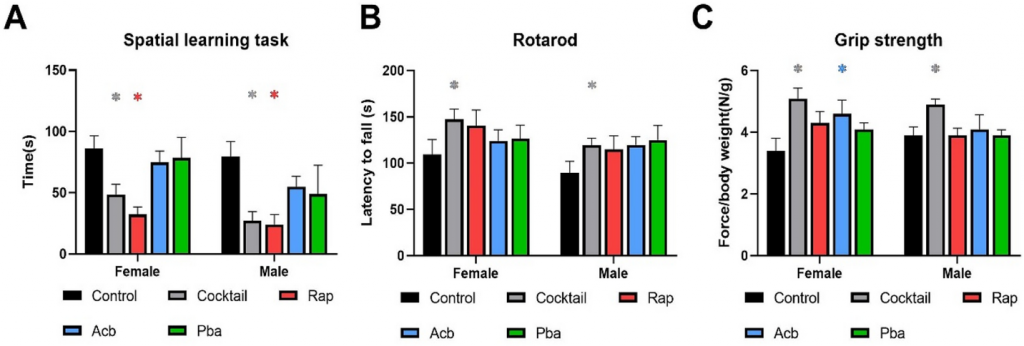Key Points:
- Combined treatment with rapamycin, acarbose, and phenylbutyrate leads to a reduction in fat mass in aged mice.
- The combined treatment cocktail improves learning, as well as endurance and strength.
- Age-related heart, lung, liver, and kidney lesions are reduced by the treatment cocktail.
We often think of aging as one process, but multiple biological pathways contribute to the eventual organ and tissue dysfunction that characterize aging. Therefore, targeting multiple pathways with a combination of interventions may prove more effective at slowing down aging than any single drug individually. This is exactly what Jiang and colleagues from Washington University tested in their new study published in Scientific Reports.
Jiang and colleagues found that combining rapamycin, acarbose and phenylbutyrate, each shown to prolong lifespan or improve healthspan individually, prevents several manifestations of aging in mice. This includes a reduction in fat mass, improvements in cognition, enhanced endurance and strength, and a reduction in age-related lesions. These findings suggest that a treatment cocktail like the one in this study could more effectively slow down the aging process than any one intervention alone.
New Drug Cocktail Reverses Signs of Aging
Jiang and colleagues treated middle-aged mice with a cocktail of rapamycin, acarbose, and phenylbutyrate for three months. They found that mice fed the cocktail had a reduction in fat mass compared to non-treated mice. The reduction may have been due to acarbose — a popular type 2 diabetes medication that regulates glucose — because, without the other two drugs, it also reduced fat mass.
The mice fed the cocktail also had improvements in learning. This was measured by the time the mice took to escape a spatial learning maze. The improvement in learning may have been due to rapamycin — an antibiotic that inhibits the nutrient signaling complex mTOR— because, without the other two drugs, it also reduced maze escape times.
The Washington-based researchers also tested measures of endurance and strength. Endurance was tested by placing the mice on a spinning rod (rotarod) and measuring the time it took for them to fall, with longer times on the rod indicating enhanced endurance. Strength was measured by a device that records the force produced by the mouse when it grips a specially designed grid, with higher force indicating enhanced strength. In general, mice fed the cocktail outperformed mice fed individual drugs. Overall, these findings demonstrate that combining three anti-aging treatments may be superior to just one when it comes to fat loss, learning, endurance, and strength.

To determine the effects of the drug cocktail on organ dysfunction, Jiang and colleagues measured the severity of lesions in the heart, lung, liver, and kidney. They found a decrease in lesion severity in mice fed the cocktail. Individually, rapamycin, acarbose, or phenylbutyrate were less effective than the cocktail, except for rapamycin, which tended to only be effective in females. Additionally, the drug cocktail lowered inflammatory gene activation in the kidney. These findings suggest that the drug cocktail delays organ dysfunction, possibly by reducing inflammation.

A Future of Synergizing Therapies
The findings of Jiang and colleagues demonstrate that when it comes to anti-aging therapy, a combination of drugs may be superior to any one drug alone. This may not be surprising, as each of the drugs in this study has been shown to prolong lifespan or slowdown age-related diseases. The drugs were chosen because they target different but overlapping pathways associated with aging. By inhibiting mTOR, rapamycin blocks protein synthesis pathways. Acarbose is involved in pathways associated with glucose regulation and has similar effects to caloric restriction, another life extending intervention in mice. Phenylbutyrate occurs naturally in the gut, previously shown by the authors to enhance physical and cognitive performance.
The availability and safety of the drugs used in Jiang and colleagues’ cocktail vary. Rapamycin, also called sirolimus is an immunosuppressant, used in the clinic to prevent the rejection of organ transplants. Based on animal studies, it appears to be the most promising anti-aging drug as far as extending lifespan. Rapamycin also reverses brain and gut aging in mice. However, while lower doses of rapamycin seem to be beneficial for off-label use, higher doses could lead to adverse side effects. Some would say that rapamycin is safe only for sick patients, but more research is needed to support this conclusion.
As a type 2 diabetes medication, acarbose can prevent diabetes and has now gained traction as a preventative measure for obesity and cardiovascular disease. While the side effects of acarbose seem to be minor, more research is needed to test its effects in healthy individuals. A medication containing phenylbutyrate has recently been shown to increase the survival of amyotrophic lateral sclerosis (ALS) patients by 4.8 months, supporting its anti-aging effects in humans. However, like with acarbose and rapamycin, more research is needed to determine the safety and efficacy of phenylbutyrate in healthy individuals.
Overall, it would seem that combining the correct doses of rapamycin, acarbose, and phenylbutyrate could potentially have synergetic effects in humans that could slow down the aging process. Although there were none observed in this study, other combinations of drugs could interact with each other leading to negative outcomes. Therefore, future studies could test different combinations of anti-aging drugs to determine whether their efficacy is improved, negated, or diminished.